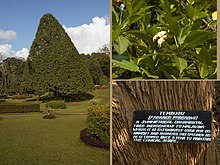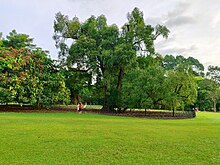|
Tembusu
 The tembusu is a large evergreen tree in the family Gentianaceae, native to Southeast Asia (from Indo-China to New Guinea). It is the Malay name for Cyrtophyllum fragrans (synonym Fagraea fragrans).[2] Its trunk is dark brown, with deeply fissured bark, looking somewhat like a bittergourd. The tree grows in an irregular shape from 10 to 25 metres high,[3] with light green oval-shaped leaves, and yellowish flowers with a distinct fragrance. The fruits of the tree are bitter tasting red berries, which are eaten by Pteropus fruit bats.[4] Common namesBuabua (Fiji Islands), Urung (Philippines), Temasuk (Sabah), Tatrao, Trai (Vietnam), Kan Krao (Thailand), Tembesu (Indonesia), Anan, Anama (Burma), Munpla (Thailand, Laos), Ta Trao (Cambodia).[citation needed] UsesThe trunk of this tree can produce very hard wood that can be used to make chopping boards and floors.[citation needed] The wood can last over a hundred years, as it is not consumed by termites and weevils. Cultural significanceA distinctive and well-loved tembusu tree growing in the Botanic Gardens is pictured on the Singaporean five-dollar bill.[citation needed] In Thailand, it is the provincial tree of Surin Province and the university tree of Ubonratchathani.[citation needed] References
External links
|
||||||||||||||||||||||||||||||||||||

